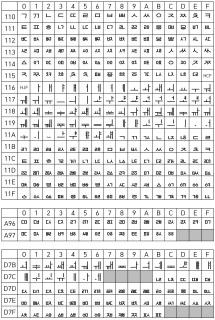Related Research Articles
CJK Radicals Supplement is a Unicode block containing alternative, often positional, forms of the Kangxi radicals. They are used as headers in dictionary indices and other CJK ideograph collections organized by radical-stroke.
Enclosed Alphanumerics is a Unicode block of typographical symbols of an alphanumeric within a circle, a bracket or other not-closed enclosure, or ending in a full stop.
CJK Unified Ideographs Extension-A is a Unicode block containing rare Han ideographs.
CJK Symbols and Punctuation is a Unicode block containing symbols and punctuation used for writing the Chinese, Japanese and Korean languages.

Hangul Jamo is a Unicode block containing positional forms of the Hangul consonant and vowel clusters. They can be used to dynamically compose syllables that are not available as precomposed Hangul syllables in Unicode, specifically syllables that are not used in standard modern Korean.
Katakana is a Unicode block containing katakana characters for the Japanese and Ainu languages.
CJK Unified Ideographs Extension B is a Unicode block containing rare and historic CJK ideographs for Chinese, Japanese, Korean, and Vietnamese.
CJK Unified Ideographs Extension C is a Unicode block containing rare and historic CJK ideographs for Chinese, Japanese, Korean, and Vietnamese.
CJK Unified Ideographs Extension D is a Unicode block containing rare and historic CJK ideographs for Chinese, Japanese, Korean, and Vietnamese.
CJK Compatibility Ideographs Supplement is a Unicode block containing Han characters used only for roundtrip compatibility mapping with planes 3, 4, 5, 6, 7, and 15 of CNS 11643-1992.
CJK Compatibility Ideographs is a Unicode block created to contain Han characters that were encoded in multiple locations in other established character encodings, in addition to their CJK Unified Ideographs assignments, in order to retain round-trip compatibility between Unicode and those encodings. Such encodings include the South Korean KS X 1001:1998, Taiwanese Big5, Japanese IBM 32, South Korean KS X 1001:2004, Japanese JIS X 0213, Japanese ARIB STD-B24 and the North Korean KPS 10721-2000 source standards.
Ideographic Description Characters is a Unicode block containing graphic characters used for describing CJK ideographs. They are used in Ideographic Description Sequences (IDS) to provide a description of an ideograph, in terms of what other ideographs make it up and how they are laid out relative to one another. An IDS provides the reader with a description of an ideograph that cannot be represented properly, usually because it is not encoded in Unicode; rendering systems are not intended to automatically compose the pieces into a complete ideograph, and the descriptions are not standardized.
CJK Strokes is a Unicode block containing examples of each of the standard CJK stroke types.
Enclosed CJK Letters and Months is a Unicode block containing circled and parenthesized Katakana, Hangul, and CJK ideographs. Also included in the block are miscellaneous glyphs that would more likely fit in CJK Compatibility or Enclosed Alphanumerics: a few unit abbreviations, circled numbers from 21 to 50, and circled multiples of 10 from 10 to 80 enclosed in black squares.
CJK Compatibility Forms is a Unicode block containing vertical glyph variants for east Asian compatibility. Its block name in Unicode 1.0 was CNS 11643 Compatibility, in reference to CNS 11643.
CJK Compatibility is a Unicode block containing square symbols encoded for compatibility with east Asian character sets. In Unicode 1.0, it was divided into two blocks, named CJK Squared Words (U+3300–U+337F) and CJK Squared Abbreviations (U+3380–U+33FF).
Enclosed Ideographic Supplement is a Unicode block containing forms of characters and words from Chinese, Japanese and Korean enclosed within or stylised as squares, brackets, or circles. It contains three such characters containing one or more kana, and many containing CJK ideographs. Many of its characters were added for compatibility with the Japanese ARIB STD-B24 standard. Six symbols from Chinese folk religion were added in Unicode version 10.
Halfwidth and Fullwidth Forms is the name of a Unicode block U+FF00–FFEF, provided so that older encodings containing both halfwidth and fullwidth characters can have lossless translation to/from Unicode. It is the last of the Basic Multilingual Plane excepting the short Specials block at U+FFF0–FFFF. Its block name in Unicode 1.0 was Halfwidth and Fullwidth Variants.
Variation Selectors is a Unicode block containing 16 Variation Selector format. They are used to specify a specific glyph variant for a preceding character. They are currently used to specify standardized variation sequences for mathematical symbols, emoji symbols, 'Phags-pa letters, and CJK unified ideographs corresponding to CJK compatibility ideographs. At present only standardized variation sequences with VS1, VS2, VS3, VS15 and VS16 have been defined; VS15 and VS16 are reserved to determine whether or not a character should be displayed as an emoji.
CJK Unified Ideographs Extension E is a Unicode block containing rare and historic CJK ideographs for Chinese, Japanese, Korean, and Vietnamese.
References
- ↑ "Unicode character database". The Unicode Standard. Retrieved 2016-07-09.
- ↑ "Enumerated Versions of The Unicode Standard". The Unicode Standard. Retrieved 2016-07-09.
- ↑ "3.8: Block-by-Block Charts" (PDF). The Unicode Standard. version 1.0. Unicode Consortium.